
Using the Right Section and Chapter Titles
We covered preset styles in previous chapters, but these styles can be used to quickly create chapters, sub-headers and title pages. Styles are found in the "Home" ribbon tab, which is where many of the text formatting options are found. When you need to find a way to format text and content, the first place to check to find what you're looking for is in the "Home" ribbon tab.
When you create a new blank Word document, click the "Home" tab to see a list of preset styles.

(Styles category for font formats)
In the image above, the "Normal" style is selected. This is the default style that indicates to Word that you want to type in the font and style selected as the blank template's default. Notice that there are three styles named "Heading 1," "Heading 2," and "Title." These three styles are the most important for long technical documents. These styles are used in creating a table of contents (covered in the next section).
The "Title" text indicates a new chapter to the table of contents generator. Use this style when you create a new chapter or main section. Most documentation separates chapters or main sections using a page break. We'll cover page breaks in a later section as well.
The "Heading 1" text formatting indicates to the table of contents generator that a new sub-section should be shown in the listings. A sub-header displays as a sub-section under a new chapter. Even further, the "Heading 2" option sets text as a sub-section of a sub-section. This allows you to create granular sections in long technical documentation that can be noted in a table of contents. For long documents, you should always have a table of contents to make it easier for readers to find the content that they are looking for.
You'll notice that the "Styles" category has several more options and preset styles that you can use. You can also customize styles for your documents, which was covered in earlier chapters.
Creating a Table of Contents
We haven't covered any Word features in the "References" ribbon tab. This tab contains several functions for creating citations, lookup research links, footnotes and a table of contents. The table of contents feature is what's used the most in long technical documentation. Click the "References" ribbon tab, and you'll find the "Table of Contents" button on the right side of the tab in the "Table of Contents" section.

(Table of Contents buttons)
Clicking the button opens a dropdown with a list of options.
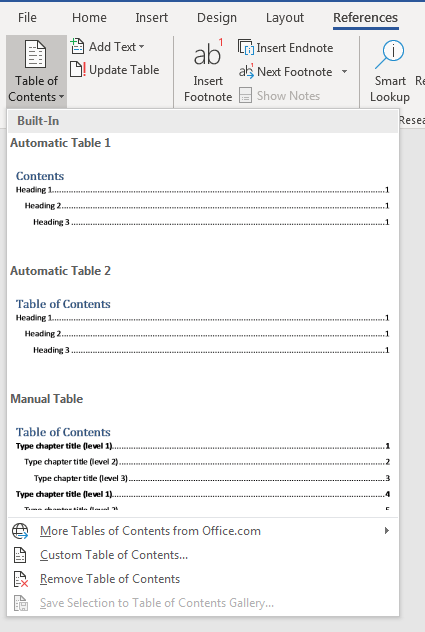
(Table of Contents dropdown options)
Notice that each option has its own style, but the "Manual Table" option lets you create a manual table. This is usually unnecessary since the automatic creation of a table of contents has the option to automatically update page numbers and titles when you change them. For instance, suppose that you create a table of contents, but later add some content to an earlier chapter. This can shift page numbers down for all subsequent chapters. With a manual table, you'll need to go back to the table of contents and change page numbers for each chapter. This can be tedious should you make several changes to your technical documentation. You can skip this tedious step using an automatic table.
Click the "Automatic Table 1" and notice that each page that contains a preset style explained in the previous section has its own listing with its subsequent page number. This is the easiest, fastest and most conveniently update way to create a table of contents in long documentation.
Should you create a table and later make changes to your document, you can do this by clicking the table of contents, and then clicking the "Update Table" option. This will update any changes to chapter titles, headings and page numbers. You don't need to add any manual text unless you decide to customize any of the text within the table.
Adding Page Breaks
When creating long technical documentation, you need page breaks to separate chapters. You could just keep creating chapters without them, but page breaks make it easier for your readers to decipher different sections of a document. They also provide a way for a table of contents generator to separate page numbers based on the style used for a chapter's text. Professional documentation uses page breaks, so for long documentation is good to know how to use them.
The page break controls are found in the "Insert" ribbon tab. Click the tab, and you'll find the controls in the "Pages" section on the left side of the tab.
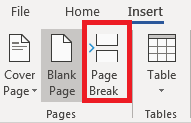
(Pages controls in the "Insert" ribbon tab)
Page breaks give you control over when a new page is created regardless of the position of the cursor and the amount of text entered on a page. Normally, a new page is only created as you create more text or add images that span the height of the page. When your content spans past the height of the page based on print margins, a new page is created, and any new content is pushed to this new page. With a page break, you can control when a new page break is created.
Click the button in the "Pages" section in the location of a page where you want to stop text and create a new page. Any content prior to the page break will still remain on the previous page, and a new page is created. Content created after the page break will display on the next page.
Customizing Borders and Background Colors
The standard background for a Microsoft Word page is white, and pages contain no visible borders, but these default settings can be changed. In the "Design" ribbon tab, there are two controls that handle these preferences: Page Color and Page Borders.
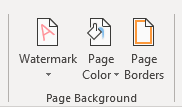
(Page background controls)
We covered the "Watermark" option in the Desktop Publishing chapter. This design option creates text on a document to protect your copyright. The "Page Color" and "Page Borders" option creates custom colors and borders that surround your content. This can be used in desktop publishing content, but it can also be used to custom the background of technical document. For instance, some white papers have custom backgrounds and borders to make them more attractive and to match them to website brand colors.
Click the "Page Color" button and a dropdown menu appears with a list of colors to choose from.
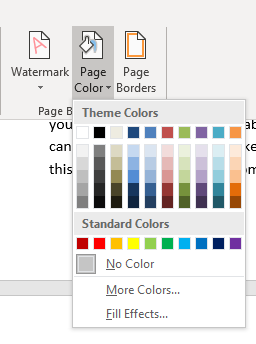
(Page color options)
You can choose from any of the listed preset colors, but you can also customize a color if you don't like the them colors listed. Click the "More Colors" option, and a larger color palette opens. You can choose a custom color by using the picker or you can enter the hexadecimal value for the color that you want for a page's background.
For page borders, click the "Page Borders" button and a configuration window opens.
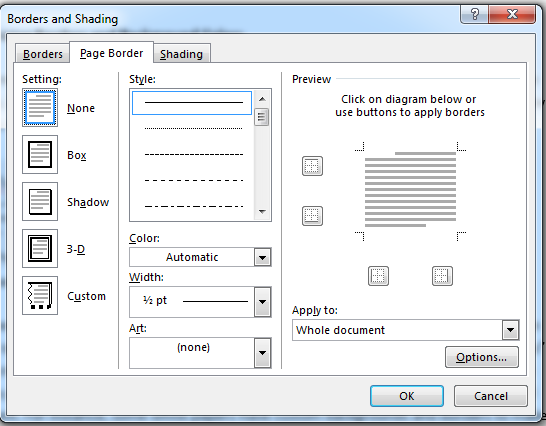
(Page border configuration window)
These options are similar to the borders you'll find for Word and Excel tables. You'll notice that border styles, colors, width and art are similar to borders across all Microsoft Office software. Word also provides preset settings shown in the left section of this window. The "Shading" option lets you set an opaqueness preference and color for the gradient. When you create a page border, the lines will display around the entire page unless you change the "Apply to" setting in the dropdown. With page borders, you can create a style that makes pages stand out from others.
Long technical documentation takes time to stylize, but the result provides a published document that stands out from standard published content. These styles and settings are beneficial for content that you want to publish such as pamphlets and white papers.
Line Numbering
By default, Microsoft Word numbers every line in a document except for those in tables, footnotes, endnotes, text boxes, frames, as well as headers and footers. However, it does not show these line numbers. You have to specify if you want Word to show line numbers and which ones to display. This is especially helpful in technical papers to create reference points. You can display line numbers in all or part of a document, or at certain intervals such as every tenth line.
To display line numbers, go to the Layout tab. Click on Line Numbers in the Page Setup group, as shown below. Line Numbers is right below Breaks.
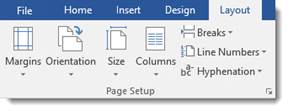
If you click the Line Numbers button, you will see this dropdown menu:

As you can see, None is selected by default. You can also select:
Continuous to display every line number within the document. Microsoft Word will label the first line "1," the second line "2," and so on throughout the entire document.
Restart on each page means that each page's first line will be numbered �1."
Restart Each Section means that line numbering will start over in each section. You must use headers for Microsoft Word to be able to do this.
Suppress for Current Paragraph means you can select a paragraph and select this option to that the paragraph's lines are not numbered.
If you want more exact specifications (such as line numbering at certain intervals), click on Line Numbering Options.

Click the Line Numbers button that appears above the OK button.
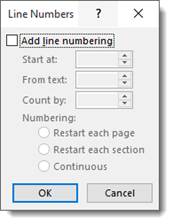
You can use this window to set intervals. Check the Add Line Numbering box, then specify the page where you want to start numbering lines. Set the rest of the options, then click OK.
References and Citations
If you have ever written a term paper, you know how important (and time consuming) writing a bibliography and citing sources can be. But guess what? Microsoft Word helps you do all those things quickly and easily.
The first thing you need to do when creating a bibliography or citing sources in Microsoft Word is to select the style you want it formatted in. To do this:
Click the References tab in the Ribbon.

Click the Style dropdown menu under the Citations and Bibliography group and select the style you want to apply.

How to Insert Citations
A citation is giving credit to a source in the body of the document. For instance, if you used a quote from a magazine article, you would want to cite the article, author, and magazine after the quote.
To insert a citation:
- Go to the References tab in the Ribbon.
- Click on Insert Citation
 in the Citations and Bibliography group.
in the Citations and Bibliography group. - Choose the appropriate option item from the dropdown menu. You can choose to insert a source by clicking on it or just insert a placeholder. In the following example, you can see that we have already added two sources. The first is a book by Paul Laurence Dunbar, and the second is a book by Jane Kramer. If we had not already added these sources, we would only see an option to add a new source or to add a new placeholder.
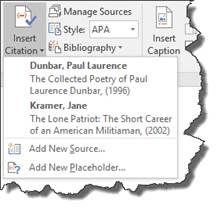
- If you have not created any sources yet, you can do so by clicking the Add New Source button. Alternatively, you can click the Manage Sources button. Then fill out the following form.
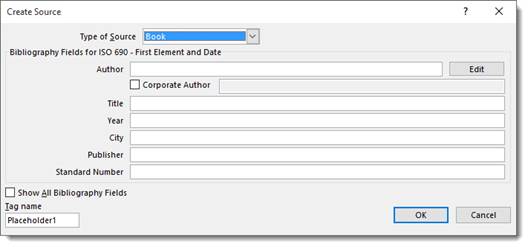
Placeholders
Use placeholders when you need to insert a source, but do not yet have all the information you need.
To insert a placeholder:
- Go to the References tab on the Ribbon.
- Click Insert Citation
- Select Add New Placeholder
- You can type in any name for the placeholder that you would like.
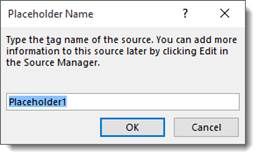
Manage Sources
If you ever need to add or delete sources, modify them, or go back and enter information for a placeholder, you can do this simply by managing your sources.
To manage your sources:
- Go to the References tab
- Select Manage Sources.

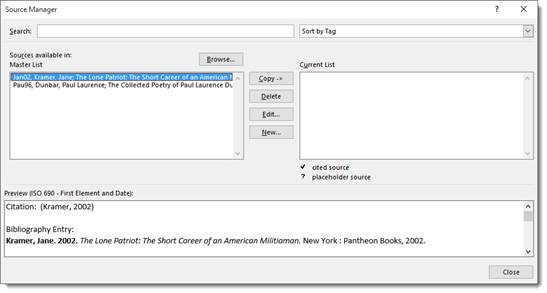
Now you can manage all your sources easily and quickly.
Adding a Bibliography
To add a bibliography to your document, go to the References tab in the Ribbon. In the Citations and Bibliography group, select Bibliography. You can choose from one of the bibliography layouts listed.

Creating an Index
An index is simply a list of terms that you used in a document with the page numbers where those terms appear. It is kind of like a glossary, just without the definitions. You can mark words, phrases, symbols, etc., for inclusion into the index. You mark them in your document, then create the index. Let's learn how to do that.
To insert an index into a Microsoft Word document, you must first mark entries that will be indexed.
Marking Entries
Start out by selecting the word or phrase that you want to index. Go to the References tab, then click Mark Entry in the Index group.
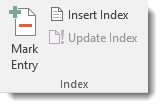
You will then see this window:

The text that you selected is the text that will appear in the index. If you want something else to appear in the index, then type that into the Main Entry box. For example: if you selected the word "cow" within your document, it will appear as Cow in the Main Entry box above. If you want "cow" to appear as Cattle instead, type Cattle in the Main Entry box. You can also type a subentry. This might be "Longhorns."
You can also create a cross reference to another index entry. If you want to do that, select Cross-Reference in the options group. Perhaps you want to cross reference cattle with dairy farm.
Now, you can specify the way that the indexed page numbers appear. You can make them boldface or italic by using the checkboxes at the bottom of the window above.
If you want to format the text for your index, right click on the text in the Main Entry or the Subentry box. You will then see this dropdown menu:

Select Font and click on it. You will then see this window:

You can now change your font type, style, size, etc. Click OK when you are finished. When you are finished marking an entry, click Mark. If you want to mark all entries, click Mark All.
Marking Text over Multiple Pages
If you want to mark text that is rather lengthy, such as a few pages in length, here is how to do it.
First, bookmark the text. You can bookmark text by selecting it, then clicking the Insert tab on the Ribbon. In the Links group, select Bookmark. We will cover this more in depth in just a minute.
Now, type in a name for the bookmark, and click add.
Now, position the cursor after the bookmarked text, then go to the References tab and click on Mark Entry. Name it. When you select Page Range, you can choose your bookmark from the Bookmark dropdown list.
Adding the Index
When you are finished marking entries, it is time to create the index. Simply move the cursor to where you want the index to appear. Then go to the Reference Tab and click on Insert Index.

Now you can set the preferences and options for your index:

-
Right align page numbers means that all your page numbers will appear on the right and neatly � one under the other.
-
Tab leader is only available if you right align page numbers. Tab leader means that a dotted line, dashed line, or straight line will appear from the entry to the page number.
-
Formats means that you can choose a format to change the style of the index. A format is shown in the Print Preview window.
-
Type. If you choose indented, each entry will appear on a new line. Run-in displays entries one after the other with multiple entries on the same line.
-
Columns determines how many columns your index will have.
When you are finished, click OK. Microsoft Word will collect all of your marked entries for the index, sort them alphabetically, reference their page numbers, then display your index in your document.
Formatting Marks
Formatting marks are marks that show the ends of paragraphs, spaces between words, indentions, etc. If you want to see the formatting marks in your document, go to the Home tab, then click on Show/Hide, as shown below. By default, formatting marks are hidden.

When you show formatting marks, your document now looks like this:

Inserting Special Characters into Your Document
Special characters refer to punctuation, symbols, or other items that are not generally available on keyboards, such as copyright symbols, trademark symbols, etc.
To insert special characters or symbols:
- Place your cursor where you want the symbol to appear.
- Click the Insert tab.
- Click the Symbols button in the Symbols group.
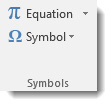
- Choose the symbol you want from the dropdown menu, or click on More Symbols.

Inserting Equations
You can create and insert mathematical equations into your document using Microsoft Word.
To do this:
- Place your cursor where you want the equation.
- Select the Insert tab.
- Click the equation button (located beneath Symbol) and select your equation from the dropdown menu. If you do not see the equation you want, select Insert New Equation. This box will then appear in your document:
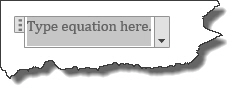
And you will see this toolbar in the Ribbon:

Select your equation.
To edit an equation, click Design in the Ribbon while the equations dialogue box is open. (See above picture.)
Adding Footnotes
If you need to add footnotes to your document, you can do this by going to the References tab in the Ribbon. Go to the Footnotes group. From there, you can insert a footnote, view and edit footnotes, and also add endnotes.
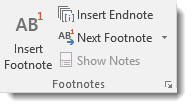
Adding Bookmarks
You can use bookmarks in Word the same way you would use a bookmark to mark a page of a book so you can pick up reading where you left off. You bookmark text by selecting it, then clicking the Insert tab on the Ribbon. In the Links group, select Bookmark.
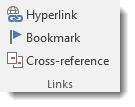
Now, type in a name for the bookmark, then click add.
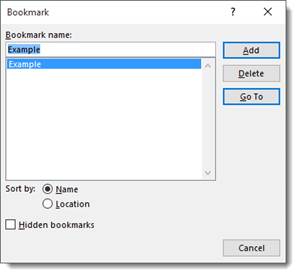
Cross-reference
You can also insert a cross-reference to refer someone to another portion of a document. To start with, type the introductory text for the cross reference, such as "See Page 3."
To do this, go to the Insert tab, then click Cross-reference in the Links group.
You will see this box:
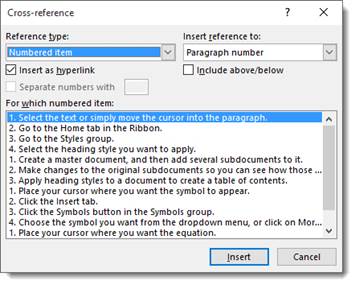
- In the Reference type box, select what you want to refer to. Maybe you want to refer to a heading.
- In the Insert Reference To box, click the information that you want inserted into your document.
- In the For Which box, select the item that you want to refer to. If you want users to be able to jump to that item, make sure the Insert as Hyperlink box is checked.
Click Insert.
Insert a Hyperlink
A hyperlink is a link to a website or location on the Internet � or even your computer if the person reading your document has access to your computer files. To insert a hyperlink into a document, go to the Insert tab, then the Links group. Click the Hyperlink button.
You will see this window:
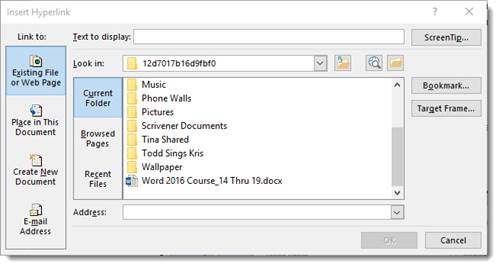
In the Text To Display field, enter in the text you want displayed in your document. This will be the text people can click on to take them to the web page. It does not have to be a URL. You can type in the word "cow" if you want.
Now, let Word know what to link to.
Go to the column on the left and choose a file or web page, a place within your document, a new document, or an email address for an email link.
Then let Word know where to look, either on your computer, on web pages you have recently visited, etc.
You can also type in the address in the bottom field.




























